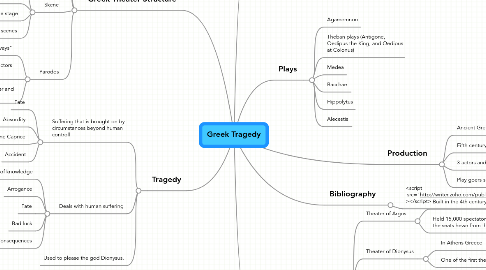
1. Tragedy
1.1. Suffering that is brought on by circumstances beyond human controll
1.1.1. Fate
1.1.2. Absurdity
1.1.3. Divine Caprice
1.1.4. Accident
1.2. Deals with human suffering
1.2.1. Lack of knowledge
1.2.2. Arrogance
1.2.3. Fate
1.2.4. Bad luck
1.2.5. Consequences
1.3. Used to please the god Dionysus.
2. Greek Theater Structure
2.1. Orchestra
2.1.1. "Dancing space"
2.1.2. Usually circular
2.2. Thearon
2.2.1. "Viewing space"
2.2.2. Part of the hillside overlooking the orchestra
2.3. Skene
2.3.1. "The tent"
2.3.2. 25 feet wide and 10 feet deep
2.3.3. In the back of the stage
2.3.4. Actors used it for special scenes
2.4. Parodos
2.4.1. "Passageways"
2.4.2. Where the chorus and actors made their entrances
2.4.3. Audience used it to enter and exit as well
3. Writers
3.1. Aeschylus
3.1.1. c. 525-456 B.C.E
3.2. Sophocles
3.2.1. c. 469-406 B.C.E
3.3. Euripides
3.3.1. c. 485-406 B.C.E
4. Production
4.1. Ancient Greece
4.2. Fifth century B.C.E
4.3. 3 actors and a chorus of 12
4.4. Play goers set on the thearon
5. Plays
5.1. Agamemnon
5.2. Theban plays (Antigone, Oedipus the King, and Oedipus at Colonus)
5.3. Medea
5.4. Bacchae
5.5. Hippolytus
5.6. Alecestis
6. Some Famous Theaters
6.1. Theater of Argos
6.1.1. Built in the 4th century BC
6.1.2. Held 15,000 spectators on the seats hewn from the rock
6.2. Theater of Dionysus
6.2.1. In Athens Greece
6.2.2. One of the first theaters
6.3. Theater of Corinth
6.3.1. First was built by Emperor Hadrian and had 15,000
6.3.2. Located in Corinth
6.4. Theater of Cassope
6.4.1. Hellenistic theater at Cassope
6.4.2. Built at the northwest edge of the city on a rocky hillside
6.4.3. Second theater to the south
